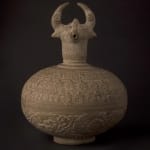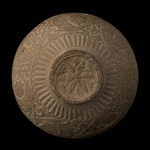Islamic Terracotta Vessel, 700 CE - 900 CE
Terracotta
6 x 8.5
PF.5124
Jug with zoomorphic head, yellowish earthenware with extensive moulded decoration. This superb pitcher is composed of two main parts -the spherical body made of two halves attached in the middle-...
Jug with zoomorphic head, yellowish earthenware with extensive moulded decoration. This superb pitcher is composed of two main parts -the spherical body made of two halves attached in the middle- and the spout/handle section.
Both sections have been richly decorated with moulded floral scrolls and blossoming flowers; on the shoulder Kufic inscription; the cylindrical neck, separately made then attached to the top of the body, is decorated with incised vertical lines, terminating in a horned animal’s head. The base, surrounding the low foot-ring is decorated with series of leafs, while at the bottom inside the ring is blossoming rosette.
Four registers encircle the body, beginning with a series of joined oblong “lozenges” at the base, continuing into a floral effect that is slightly wider and freer than the more detailed panel above. A series of glyph-like configurations dominate the upper area, before allowing a more open space at the neck. The tightly woven designs of the body, like a complex script, are beautifully contrasted to the elegant bull's head attached to the spout. Its stylized nature in fact adds to its power; with intense, circular eyes, dramatically curved horns and an ornate pattern covering the face and neck.
Syria, Umayyad or early Abbasid period, 7th – early 9th c. Geza Fehervari - (PF.5124)
Both sections have been richly decorated with moulded floral scrolls and blossoming flowers; on the shoulder Kufic inscription; the cylindrical neck, separately made then attached to the top of the body, is decorated with incised vertical lines, terminating in a horned animal’s head. The base, surrounding the low foot-ring is decorated with series of leafs, while at the bottom inside the ring is blossoming rosette.
Four registers encircle the body, beginning with a series of joined oblong “lozenges” at the base, continuing into a floral effect that is slightly wider and freer than the more detailed panel above. A series of glyph-like configurations dominate the upper area, before allowing a more open space at the neck. The tightly woven designs of the body, like a complex script, are beautifully contrasted to the elegant bull's head attached to the spout. Its stylized nature in fact adds to its power; with intense, circular eyes, dramatically curved horns and an ornate pattern covering the face and neck.
Syria, Umayyad or early Abbasid period, 7th – early 9th c. Geza Fehervari - (PF.5124)



